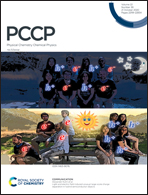Exploring the mechanism and counterion activity regulation in the CoIII(salen)-catalyzed hydration of propylene oxide†
Abstract
CoIII(salen)–X (X = Cl−, OAc−, and OTs−) mediated hydration of propylene oxide (PO) to propylene glycol has been investigated in detail using density functional theory (DFT) calculations. Two kinds of reaction mechanisms, the concerted and stepwise pathways, were scrutinized. For the eight concerted routes, the cooperative bimetallic route in which the middle carbon atom is attacked by the nucleophilic oxygen atom (route VI-m) was calculated to be the most favorable, and among the three catalysts examined H2O–CoIII–OTs was found to be the most active, due to the strong hydrogen bonding between the nucleophilic H2O and the ring oxygen atom in the epoxides as well as the extra π–π stacking interaction. For the stepwise mechanism which consists of the formation of H2O–CoIII–OH, the ring-opening of PO and propylene glycol formation, our studies reveal that different H2O–CoIII–Xs behave kinetically very similarly in the course of propylene glycol formation, but show a notable difference in the rate of H2O–CoIII–OH formation with Cl− > OAc− > OTs−. The rate ordering with which we rationalize the experimental phenomena well is disclosed to be consistent with the nucleophilicity of the counterions by molecular electrostatic potential, condensed Fukui function and condensed local softness. We show that the nucleophilicity of the counterion determines the favorable mechanism that PO hydration follows.



 Please wait while we load your content...
Please wait while we load your content...